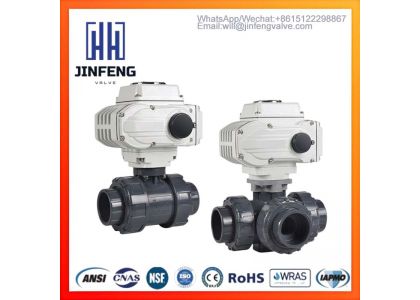
2 Way Motorized Ball Valve
Number of Ports: Two—one inlet and one outlet
Functionality: The 2-port motorized valve cannot control the flow direction of the medium. It operates solely in two states: open, allowing the medium in the pipeline to flow, and closed, blocking the flow of the medium in the pipeline.
Control Method: Most 2-way motorized ball valves operate in an on/off mode, opening when energized and closing when de-energized. Some intelligent actuators can also achieve angular modulation of the valve by inputting different electrical signals.
Advantages:
1. Easy installation and low maintenance costs: The internal structure of 2-way motorized ball valves is simple, making them less prone to failure and relatively easy to repair.
2. Low cost: Due to their simpler structure and fewer components, 2-way motorized ball valves typically have lower procurement costs than 3-way motorized ball valves of the same size and material.
3. Excellent sealing performance: The straightforward sealing design effectively prevents leakage issues.
4. Low flow resistance: When energized to open, the two-way valve allows the medium to pass through with minimal resistance.
Application Scenarios
Flow control in water treatment pipelines
Controlling the flow of water at different temperatures in HVAC systems
Smart irrigation systems
Drainage systems for recreational vehicles (RVs)
3-Way Motorized Ball Valve
Number of Ports: 3
Function: Enables switching of medium flow direction and mixing of fluids, typically available in L-type or T-type configurations.
L-Type Three-Way Motorized Ball Valve: This valve can divert the flow from one inlet to either of the two outlets, but it does not allow straight-through flow.
T-Type Three-Way Motorized Ball Valve: Capable of mixing media from two inlets before discharging through a third outlet, it achieves L-type functionality with enhanced flexibility.
Advantages
1. Enhanced Functionality: A single 3-way motorized ball valve achieves both fluid diversion and convergence functions, which would otherwise require two 2-way motorized ball valves, thereby simplifying pipeline systems.
2. Space and Cost Savings: Replacing two 2-way valves with one 3-way valve reduces installation space requirements while decreasing the number of pipes and actuators needed, lowering overall control system costs.
3. Flexible Control: Simplifies switching fluid flow between different paths and enables mixing media at varying temperatures as required.
Application Scenarios
Switching between hot and cold systems
Mixing different chemical materials
If you only need to control the flow of fluid in a pipeline by opening or closing it, then an electric 2-way ball valve is the simplest and most cost-effective option.
If you need to control the direction of fluid flow, you should choose an electric 3-way ball valve.